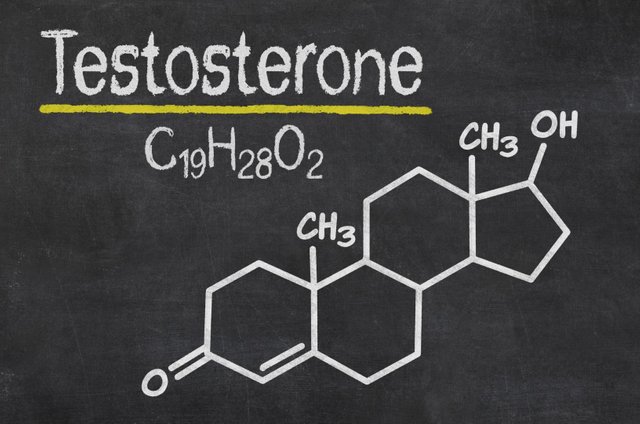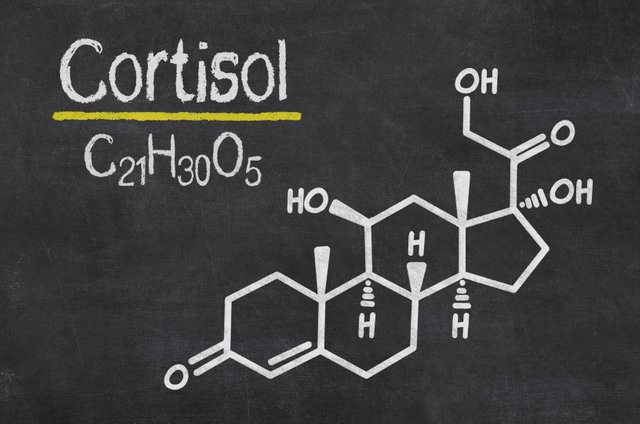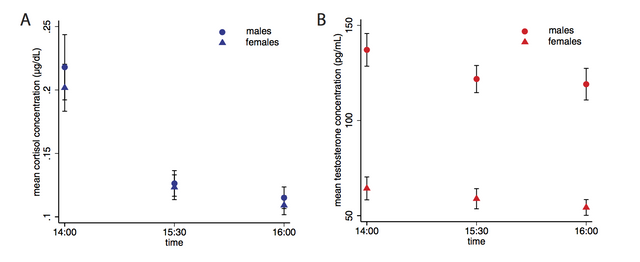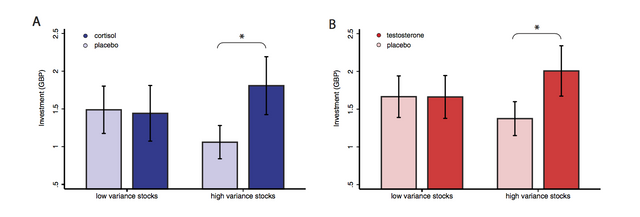Do Raised Testosterone and Cortisol Levels Increase Risky Trading?

Introduction
Following the 2008 financial crisis there have been a number of assertions that testosterone and cortisol levels may have an effect on trading activity within markets.
The specific assertion has been that they both increase risk taking behaviour (particularly in men).
I found an interesting recent study (from 2015) by Cueva et al. [1] in Nature that looks at this issue. The paper is open access and you can download it here.
Unfortunately due to the design of this study there is a lot of material to consider so apologies in advance for the long length.
As always if you are not interested in the details you can skip to the "Conclusions" section for a TLDR summary of the study.
Design
Basically the study was split in to two major parts:

Part One - Endogenous (Natural) Testosterone/Cortisol and Trading
In the first part male and female subjects took part in a trading experiment whilst their existing (unmodified) levels of cortisol and testosterone were measured:
"Male, female or mixed groups of participants traded amongst themselves, and salivary levels of cortisol and testosterone were measured before and after each trading session.
We employed an experimental design that has been used previously to analyse stock market bubbles in the laboratory, developed from an earlier paradigm. A group of typically 10 subjects traded cash and assets in a computerized bilateral exchange–a double-auction. Markets consisted of 15 trading periods, each lasting 2minutes. After each trading period, the assets yielded a random positive or negative dividend drawn from a known distribution with zero expected value. At the end of the final trading period, each asset paid a maturity value of 1GBP. Subjects entered the market with 10units of the asset and a cash loan of ~28GBP (details in supplementary material)."
For more detailed information please look at the paper itself as there is more specific information that I can't cover in this article for reasons of brevity.
The overall aim of this part of the study was to simulate a financial market situation where people are buying and selling stocks, with the behaviour of each trader being interdependent on other traders.
This would allow the potential for:
"situations of price instability, such as during bubbles or crashes, where initial price movements can become exaggerated due to herd–like behaviour and momentum trading."
The authors cite previous studies which have suggested associations between both cortisol and testosterone levels in association with these types of behaviour.
As you will often hear correlation is not necessarily causation SO the second part of the study was designed to look for direct causal affects of hormone levels.

Part Two - Administering Cortisol and Testosterone Artificially
The aim here was to see if directly administering cortisol or testosterone resulted in a change in trading behaviour.
Essentially this would differentiate correlation and causation.
For reasons which I discuss later only males were used.
The design was a double blind placebo controlled balanced crossover design.
Double blind means that neither those administering treatments/tests or those receiving them knew if they were receiving placebo or not. Crossover means that the treatments were swapped over after a certain period of time (in this case 1 week).
This can in theory reduce the effects of confounding factors (other effects which may influence the results) by making each person in effect their own control subject.
The balancing refers to making sure that the number of treatments and treatment period were equal between each subject - obviously you want people to receive the same number of doses of cortisol or testosterone. Also the timings need to be the same.
To test the separate influences of each hormone this part of the study was split into separate groups for testosterone and cortisol:
"In two separate studies, healthy young male volunteers took part in a computerized trading simulator after being administered either cortisol or (in a different group) testosterone using a double-blind placebo-controlled balanced crossover design. Each subject was tested twice, once following hormone treatment and once following placebo."
Here is a quick excerpt that explains the task - obviously if you want the full details please take a look at the paper as there is a lot more detail:
"All tasks were conducted using real monetary incentives. Our aim was to measure risk-taking in a simplified context resembling the environment faced by professional traders in the stock market. Since the focus here was on individual rather than group behaviour, we used a trading simulator that borrowed features of earlier experimental designs to allow for greater experimenter control. Subjects were shown plots of the price sequence for two ‘stocks’ and had to decide how much to invest in each over a total of 80 trials. The prices of both stocks were updated simultaneously at the end of every trial. During a trial, a subject had to [1] choose a stock, [2] enter an investment amount for that stock, [3] enter an investment amount for the alternate stock, [4] enter a guess about next period’s price for the first, and [5] for the second stock. Each decision had to be made within a 5 second time window."
The way that profits and losses worked was as follows:
"Subjects began with an endowment of 10GBP, and after every trial their endowment was updated according to their investment decisions and the new stock prices. Positive investments were profitable if the price of the stock went up but yielded losses when the price went down, with the reverse for negative investments (where the subject sells a borrowed asset that needs to be returned in the next period, i.e. a short-sale). "
Sampling and Recruitment
These are always very important when it comes to any study. I have broken them down into separate sections:

Part One: Endogenous Testosterone/Cortisol and Trading
- 142 total subjects (69M:73F).
- age 18-30, mean age 21.9.
Part Two A: Cortisol Administration Study
- 29 male subjects (after excluding 4 who failed to return for second part and 1 outlier earning 8-9 times more than others).
Part Two B: Testosterone Administration Study
- 36 male subjects (after excluding 4 drop outs and one outlier).

Inclusion and Recruitment
- Subjects were recruited from the University of Cambridge campus via volunteer lists and online advertisements.
- Age range of 18-30 used.
- Males only for administration experiments.

Exclusions
- For administration experiments females were excluded - authors say this is because most traders in markets are male.
- All other exclusions were the same for both sets of experiments.
- Drop-outs and significant outliers removed.
- Most exclusions were health related to ensure people were in good mental and physical health - see page 11 of study for full details.
- Screening used a qualified physician as well as questionnaires (e.g. Beck Depression Inventory).
Discussion
Although the authors state that the main reason for excluding females in the secondary stages of the experiment are to more accurately reflect the trading environment there is another possible reason.
Administering large doses of testosterone to females may be potentially more disruptive and problematic for a woman than for a man.
Not only could this have potential health risks but it would likely be more difficult to get ethical approval for this.

This is all the more relevant as the 18-30 age group encompasses the optimal child bearing age and one cannot be certain of the effects of such changes on a developing foetus.
Exclusions for health reasons make sense.
You don't want anyone suffering a heart attack or other stress related health event if you can possibly avoid it.
Further certain health conditions such as depression may lead to abnormal responses to hormones such as cortisol and testosterone.
The same case can be made for pre existing hormonal disorders which might skew the results.
Medications for certain disorders such as schizophrenia can also have significant effects on hormonal levels even if the illness itself is under control.
Results
Part One - Endogenous (Natural/unmodified) Testosterone/Cortisol

- Levels of both hormones generally went down during the course of the experiment from baseline.
- As expected testosterone levels were significantly higher in males.
- Cortisol levels were strongly associated with the level of trading activity in men.
- There was no significant effect of Testosterone on trading.
- Some minor other effects were seen but none reached statistical significance.
- No significant associations in women.
The authors suggest that the high levels of cortisol at baseline is consistent with the normal daily secretion of both hormones (peaking in the morning).
This may also have been exaggerated by the anticipation anxiety of taking part in the experiment.
It is interesting that correlations were much weaker in women and none reached statistical significance.
This may indicate there is not a relationship with these hormones in women or some as yet unknown factor is having an influence.
What does the correlation between higher cortisol and higher trading activity in men suggest?

The authors suggest it may be that cortisol increases risk taking behaviour. Hence men with higher cortisol are taking part in trades which they otherwise wouldn't.
If this is the case then one would expect more "risky" trades to be made when cortisol was elevated.
The authors used statistical analysis of a measure called NAD:
"normalized absolute deviation (NAD) – the sum of the deviations of prices from the fundamental value in every market transaction. This measure takes into account not just prices, but trading amounts, and is therefore richer than other common measures of mispricing and volatility such as amplitude – the difference between the highest and the lowest transaction price observed in the market or relative absolute deviation (RAD) – the mean absolute price deviation."
Further analysis did show a significant correlation between cortisol at 1400 (just after trading) and the NAD. It was also strongly associated with amplitude and more weakly with RAD.
This combined with the previous results suggests that higher cortisol levels result in "greater risk taking and mispricing at the market level".
Part Two Administration of Testosterone/Cortisol

- No effect of cortisol in overall investment amounts.
- Cortisol significantly increased investments in more risky stocks - 70% higher in the cortisol group.
- Testosterone significantly increased investments in risky stocks too - 46% higher.
- No change in investments in low risk stocks in either intervention group.
- Price expectations were not effected by cortisol but were significantly increased by testosterone.
The authors suggest that this illustrates slightly different roles for each hormone:
Cortisol levels increase risk taking behaviour - the willingness to take risks.
Testosterone increases optimism (about price increases) making more risky investments seem viable (hence less risky).
Controlling for price expectations neutralised the effect which would further support this assertion.
Further Discussion
I'm still not entirely clear on why in the first part of the experiment there would be an effect of cortisol but no significant effect from testosterone.
Given the results of the second part of the experiment we should see some kind of effect. I don't think the authors really explain this very well.

Also it is not entirely clear why there was an absence of this effect in women, although the authors do cite previous research which is consistent with this.
The overall findings are also consistent with previous research findings of an association between cortisol/testosterone levels and engaging in more risky trading.
The implied lower susceptibility of women to this may also suggest a means of counteracting this effect in trading environments i.e. by employing more female traders.
Can having more women participating in the financial markets reduce the likelihood of bubbles, crises and crashes?
It is an interesting question and one that would need further research (of a different sort) to answer.
Problems/Limitations

In addition to what I have already discussed there are some issues that relate to study design:
Sample Sizes
The usual caveats about sample sizes apply - particularly when it comes to the second part of the experiment.
It would be useful to have follow up studies with bigger sample sizes to confirm the effects.
I'm also curious if a larger sample size might bring some of the non significant effects in the first part of the experiment into significance.
Learning Effect
There is potential that in the second set of experiments where the tests were separated by a week, people may have learned to trade more effectively by the second week.
This could have skewed the results.
The authors did address this and did not find any significant effect on statistical analysis.
The only way to be sure though would be to use a non-crossover based study and compare the results.

Order Effects and Carry Over
These are other limitations that tend to be related to crossover studies in particular.
The order of giving treatments may alter the response.
This is less relevant here due to the splitting of the second part of the experiment so that only one treatment and placebo was given.
That eliminates the risk of active treatments interacting.
More potentially problematic is carry over - i.e. could the effect of the first week treatment carry over to the second week?
It would be most relevant to those who received treatment in week 1 and then placebo in week 2 - the effect of the treat may continue to act in the second week.
This would falsely reduce the difference between placebo and treatment as basically those in the placebo week would still be experiencing effects from the initial treatment.
So if this was occurring we would expect less strength in the results.
Given how strong the results are in the second part of the experiment I think it is unlikely and hence becomes less relevant.
Conclusion - the TLDR!

This study suggests that both cortisol and testosterone have effects on risk taking behaviour when it comes to making investments.
The first part of the study illustrated a strong correlation between cortisol levels and high risk investments in men but not women.
No significant association was found with testosterone levels.
Overall it suggested correlation between cortisol and risky investing but not causation.
The second part of the study involved testing the effects of administering either cortisol or testosterone versus placebo (in men) using a crossover design.
This part of the study showed strong increases in risk taking behaviour both after taking cortisol (70%) or testosterone (46%).
Further analysis suggested that cortisol increases risk taking in general, whereas testosterone increases optimism (particularly in relation to future prices).
So putting the results of both study parts together suggests that both cortisol and testosterone increase risky investing in men but by different mechanisms.
The suggested lack of association between these hormone levels and risk taking in women may be a means of mitigating risks in markets (by addressing the male:female imbalance).
The main problems with this study relate to the small sample sizes, use of only men for the second part (interventional) studies and the possibility of learning effects in the same.
As always further research should help to counter these issues and provide greater validity to the findings.
It would also be interesting to investigate the specific effect of introducing more women into a trading environment.
Would it actually reduce risk taking and be an effective mitigating factor?
References
Cueva, Carlos, R. Edward Roberts, Tom Spencer, Nisha Rani, Michelle Tempest, Philippe N. Tobler, Joe Herbert, and Aldo Rustichini. 2015. “Cortisol and Testosterone Increase Financial Risk Taking and May Destabilize Markets.” Scientific Reports 5 (July): 11206.
Wikipedia contributors. 2016. “Crossover Study.” Wikipedia, The Free Encyclopedia. August 10. https://en.wikipedia.org/w/index.php?title=Crossover_study&oldid=733812185.
Thank you for reading

Before you go have you filled in the Coinbase form to list STEEM? It only takes a few seconds. THIS POST shows you how.
If you like my work please follow me and check out my blog - @thecryptofiend
Uncredited Images are taken from my personal Thinkstock Photography account. More information can be provided on request.

NOOOO! :) How would I learn anything otherwise?
The real question is the following: are traders aware of such a study?
I'm not sure about that - I wonder if they would care?
I would tentatively say: they don't :)
@thecryptofiend who turned the geisha into a cat ? - the cat's eyes remind me of the eyes of the main character in the Memoirs of A Geisha. Interesting ... isn't cortisol produced when we're stressing out on something?
I heard this from a woman in the National Achiever's Congress I attended in Amsterdam in Dec last year where Kiyosaki and Sidney - a famous trader spoke .. hmmm.. makes me think of signing up to a trading seminar next month :) haha
Lol thanks. As for the course you should!
@thecryptofiend - I tried trading with Forex - it increased my levels of cortisol though I didn't get to measure it I felt it plus those months surely added crows feet on my eyes when I smile and fine lines on my forehead hahaha
I never thought trading could do this much skin damage than make up. I was so nervous and didn't know where to put my stop loss hahaha but in general I like the kick or the thrill of doing it. I wish I earned more though. I like stocks more - its subtle stressful hahah is there such a thing "subtle stressful?"
Now here's something I had never even considered. This will require some thought! Well written and thought out!!!
Thanks mate!
Very interesting study. I didn't know that cortisol had a bigger effect on risk-taking than testosterone.
All I'll say is, someone with both high cortisol and high T looks like a trading accident waiting to happen....
Yes it is strange.
One of the things about cortisol though is that having it consistently raised seems to nullify it's effects.
In order for it to do it's thing it needs to go up and then go down - if it is consistently high that has various secondary effects on things (including suppressing other hormones including testosterone).
That is why too much stress is bad and leads to things like depression and ill health.
I was going to add a section on some of it's peculiarities but that was almost getting as long as the rest of the post and it is already super long so I took it out.
I will look at doing a review type post on cortisol at some point in the future because most people think it is universally bad which it isn't - it actually is vital to survival and is only bad when you produce too much.
Very cleverly written indeed. I would have thought the results would be a bit more causal. Interesting find!
Thanks they were for the second part of the study but the sample size for each part of it was less than a quarter of the initial part.
higher status men get more attractive women
men compete to gain higher status
competition requires risk-taking
risk-taking involves aggression (testosterone) and stress (cortisol)
I can't source any of these assertions, and I'm too lazy to look them up. Hazelton rings a bell, even tough I'm sure her work was sexual evolution in creating cognitive bias. Can't remember.
Interesting experiment. So stress (cortisol) increased risk-taking? I would have thought it was test. Just as surprised as you.
Did the researchers use industry professionals? I am only seeing "volunteer". I have to assume that experience and knowledge would also mitigate risk-taking at some point.
anyway, I was under the impression that most of the sell-offs were triggered by automated trade programs the big pension and mutual funds were using to "protect" their assets by selling at certain floors.
They do a cortisol check on those programs? ;>
Great read! Thanks!
It might and that would be something for further studies.
This post has been ranked within the top 25 most undervalued posts in the second half of Feb 06. We estimate that this post is undervalued by $20.73 as compared to a scenario in which every voter had an equal say.
See the full rankings and details in The Daily Tribune: Feb 06 - Part II. You can also read about some of our methodology, data analysis and technical details in our initial post.
If you are the author and would prefer not to receive these comments, simply reply "Stop" to this comment.